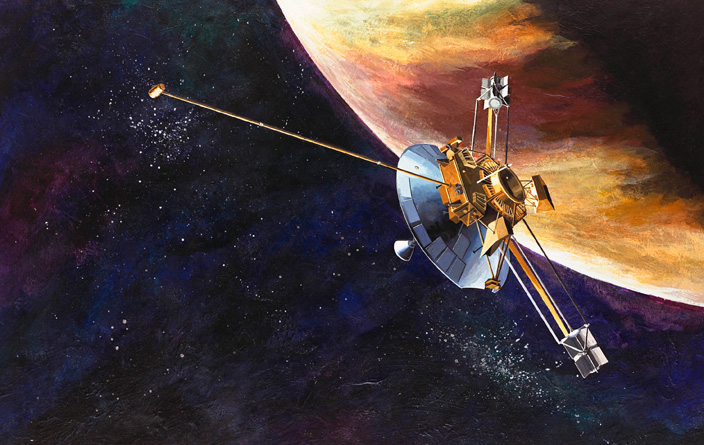Missions
Pioneer 10 & 11

Illustration of Pioneer passing Jupiter
Pioneer 10
- Launched on March 2, 1972
- Flew past Jupiter - first spacecraft to visit the giant planet
- First spacecraft to cross the asteroid belt
- First human-made object to leave the solar system
- RTGs operated for over 30 years, until communications link lost
Powered by:
Four SNAP-19 RTGs, with heat from twelve RHUs
Goals:
Pioneer 10 was the first spacecraft intended to fly by Jupiter, surviving the intense radiation that surrounds the giant planet and then on a trajectory that would take it out of the Solar System.
For more information on Pioneer 10, visit:
NASA Glenn Pioneer Launch History: Mission to Jupiter and Beyond
Accomplishments:
The spacecraft became the first to fly beyond Mars' orbit, through the asteroid belt, and close to Jupiter, blazing a trail for the two Voyager spacecraft that were to follow and conduct more in-depth surveys. During the passage by Jupiter, Pioneer 10 obtained the first close-up images of the planet, charted Jupiter's intense radiation belts, located the planet's magnetic field, and discovered that Jupiter is predominantly a liquid planet. Long before and after flying by Jupiter, Pioneer 10 transmitted data on the magnetic fields, energetic particle radiation and dust populations in interplanetary space.
Pioneer 11 was the first mission to explore Saturn and the second spacecraft in humanity's early reconnaissance of the outer solar system.
Pioneer 11
- Launched on April 5, 1973
- Flew past Jupiter and Saturn
- First spacecraft to fly past Saturn
- RTGs operated for over 22 years, until communications link lost
Powered by:
Four SNAP-19 RTGs, with heat from twelve RHUs
Goals:
Pioneer 11 was the first mission to explore Saturn and the second spacecraft in humanity's early reconnaissance of the outer solar system. The spacecraft carried instruments to study magnetic fields, the solar wind and the atmospheres, moons and other aspects of Jupiter and Saturn.
Accomplishments:
During its flyby of Jupiter Pioneer 11 obtained dramatic images of the Great Red Spot, made the first observation of the immense polar regions, and determined the mass of Jupiter's moon, Callisto.
At Saturn, Pioneer 11 took the first close-up pictures of the planet. Its instruments located two previously undiscovered small moons and an additional ring, charted Saturn's magnetosphere and magnetic field and found its planet-size moon, Titan, to be too cold for life. Hurtling underneath the ring plane, Pioneer 11 sent back amazing pictures of Saturn's rings. The rings, which normally seem bright when observed from Earth, appeared dark in the Pioneer pictures, and the dark gaps in the rings seen from Earth appeared as bright rings. It also found that the planet it emits more than twice as much heat as it receives from the Sun. Photographs revealed a more featureless atmosphere than that of Jupiter, and calculations based on data from Pioneer 11 suggested that Saturn is primarily liquid hydrogen with a core of about 10 Earth masses.
The dormant spacecraft is now headed out of our solar system in the general direction of Sagittarius, toward the center of the galaxy. Both Pioneers 10 and 11 carry a plaque with a message for any intelligent beings that might find them.
The Pioneer Anomaly
Beginning in the early 1980s NASA navigators noticed an unexpected slowing of the two Pioneers in their outward trek from the solar system. Recent analysis has shown that the slowing is due to a subtle effect of heat being given off by their radioisotope generators. Read more
